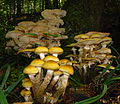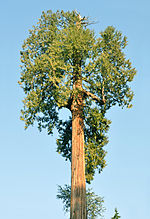Armillaria ostoyae (synonym Armillaria solidipes) is a species of fungus (mushroom), pathogenic to trees, in the family Physalacriaceae. In the western...
21 KB (2,358 words) - 23:44, 26 May 2024
mellea. Armillarias are long-lived and form the largest living fungi in the world. The largest known organism (of the species Armillaria ostoyae) covers...
16 KB (1,949 words) - 07:24, 25 April 2024
its correct epithet would be montagnei. This species was known as Armillaria ostoyae until a 2008 publication revealed that Charles Horton Peck had described...
31 KB (1,862 words) - 17:42, 6 June 2024
tonnes. The largest living fungus may be a honey fungus of the species Armillaria ostoyae. A mushroom of this type in the Malheur National Forest in the Blue...
22 KB (3,091 words) - 22:17, 17 August 2024
biological-activities, II. Occurrence of antibiotic compounds in cultures of Armillaria ostoyae growing in the presence of an antagonistic fungus or host plant-cells"...
55 KB (5,652 words) - 16:11, 22 April 2024
Armillaria mellea, commonly known as honey fungus, is an edible basidiomycete fungus in the genus Armillaria. It is a plant pathogen and part of a cryptic...
31 KB (2,939 words) - 12:03, 21 September 2024
The state is also home to the single largest organism in the world, Armillaria ostoyae, a fungus that runs beneath 2,200 acres (8.9 km2) of the Malheur National...
196 KB (16,672 words) - 12:34, 19 September 2024
susceptibility of varying degrees to the following soil pathogens: Armillaria ostoyae, Fomitopsis pinicola, Heterobasidion annosum, Phaeolus schweinitzii...
72 KB (8,473 words) - 22:31, 29 September 2024
living organism, a subterranean colonial mycelial mat of the fungus Armillaria ostoyae. The Blue Mountains were named after the color of the mountains when...
15 KB (1,444 words) - 21:55, 3 April 2024
"Early results from field trials using Hypholoma fasciculare to reduce Armillaria ostoyae root disease". Canadian Journal of Botany. 82 (7): 962–9. doi:10.1139/b04-078...
8 KB (815 words) - 00:01, 20 July 2024









